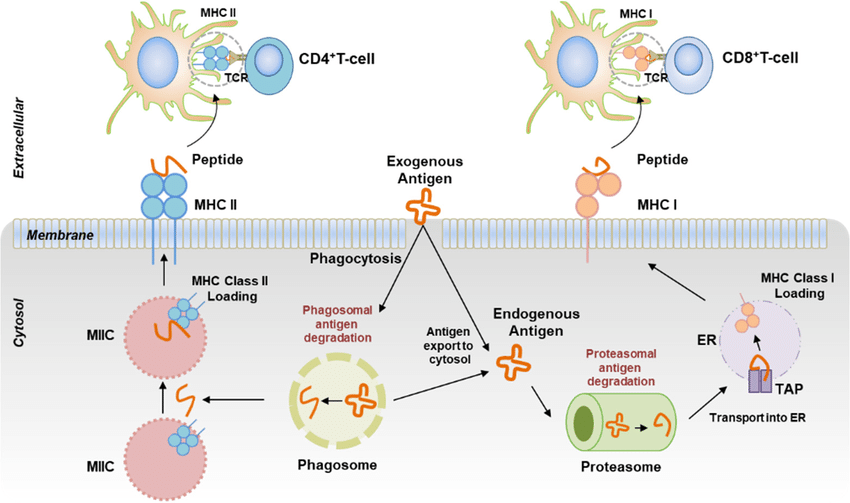Antigen presentation is a fundamental element of host defense comprising multiple steps including antigen acquisition, antigen processing, presenting peptide to the cell surface, and the response of antigen-specific T lymphocytes. Creative Biolabs provides you with the information needed to understand and assess antigen-specific responses.
Antigen cross-presentation is an adaptation of the cellular process of loading MHC-I molecules with endogenous peptides during their biosynthesis within the endoplasmic reticulum. Cross presenting cells can utilize the MHC I pathway to remain uninfected, while still triggering an adaptive immune response of activated cytotoxic CD8+ T cells against infected peripheral tissue cells.
 Fig.1 Schematic diagram for the cross-presentation machinery of dendritic cells.1
Fig.1 Schematic diagram for the cross-presentation machinery of dendritic cells.1
The molecular process of antigen processing and presentation leads to T lymphocyte activation and function to enable CD4 T cells to potentiate the humoral and cellular immune responses, and CD8 T cells to eliminate infected or tumoral cells. First, antigen-presenting cells (APCs) degrade and process the exogenous antigen or the endogenous antigen produced by cytoplasm itself to a polypeptide fragment of a certain size, so that the antigen peptide is suitable for binding to the MHC molecule, and the complex is combined. Then the complex can be transported to the cell surface. Followed by antigen presentation, the antigen peptide-MHC molecular complex expressed on the surface of APC is recognized by T cells, thereby presenting antigen peptides to T cells and inducing T cell activation. The MHCs are divided into two subgroups:
SIAT® Antigen Presentation Assay can be used to measure epitopes presented by HLA molecules to T cells. Peptides are identified by the classical method of HLA-peptide complex extraction, peptide elution, and subsequent peptide epitope identification by sequencing mass spectrometry. This service offers valuable and accurate information for epitopes from biotherapeutic drug candidates and other proteins of interest to help understand and manage their potential immunogenicity.
 Fig.2 Workflow of SIAT® antigen presentation assay service. (Creative Biolabs)
Fig.2 Workflow of SIAT® antigen presentation assay service. (Creative Biolabs)
Antigen-specific responses can be investigated in co-cultures of macrophages with isolated T cells. Activated macrophages produce cytokines such as IL-12 and IL-6 and activate and promote the proliferation of antigen-specific T lymphocytes, thereby releasing cytokine to fight infection or disease. At Creative Biolabs, we offer a variety of accurate analyses to test T cells activated by macrophages, including IFN-γ production and T cell proliferation.
As an industry-leading global CRO company, Creative Biolabs has established a powerful CAR-MA platform and provides comprehensive services for the development of CAR-MA. If you have any questions, please feel free to contact us.
Reference
For any technical issues or product/service related questions, please leave your information below. Our team will contact you soon.
All products and services are For Research Use Only and CANNOT be used in the treatment or diagnosis of disease.
 NEWSLETTER
NEWSLETTER
The latest newsletter to introduce the latest breaking information, our site updates, field and other scientific news, important events, and insights from industry leaders
LEARN MORE NEWSLETTER NEW SOLUTION
NEW SOLUTION
CellRapeutics™ In Vivo Cell Engineering: One-stop in vivo T/B/NK cell and macrophage engineering services covering vectors construction to function verification.
LEARN MORE SOLUTION NOVEL TECHNOLOGY
NOVEL TECHNOLOGY
Silence™ CAR-T Cell: A novel platform to enhance CAR-T cell immunotherapy by combining RNAi technology to suppress genes that may impede CAR functionality.
LEARN MORE NOVEL TECHNOLOGY NEW SOLUTION
NEW SOLUTION
Canine CAR-T Therapy Development: From early target discovery, CAR design and construction, cell culture, and transfection, to in vitro and in vivo function validation.
LEARN MORE SOLUTION

